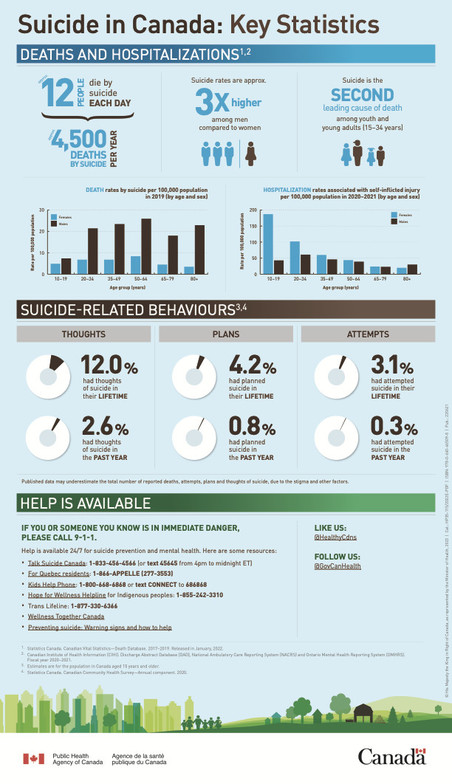
Suicide is a deeply complex and multifaceted public health issue that leaves a lasting impact not only on those lost but on families, friends, and entire communities. Its effects ripple far beyond the individual, shaping how loved ones grieve and cope, how societies respond, and how perceptions of mental health are formed.
Suicide Prevention and Awareness Month is a critical time to reflect, educate ourselves, and take action when it comes to understanding suicide, reducing its stigma, and providing support for those affected. This blog explores the scope of suicide as a public health issue in Canada, its far-reaching effects on families, and why psychoeducational programs are vital for healing and prevention.
Suicide in Canada at a Glance
Approximately 4,500 Canadians die by suicide every year—a staggering number that underscores the urgency of addressing this issue. Suicide ranks as the ninth leading cause of death in Canada. Of these deaths, 75% are men, despite women being more likely to attempt suicide. This significant disparity highlights how gender differences in mental health expression and stigma often play a crucial role in suicide prevention[^1].
Older adults, particularly men aged 85 and older, represent the group with the highest suicide rates among elderly Canadians[^1]. Factors such as isolation, chronic illness, loss of autonomy, and grief compound their risks, making this demographic a critical focus for tailored interventions. These figures remind us that suicide does not discriminate by age and points to the importance of awareness across all generations.
The Ripple Effect on Families
When someone dies by suicide, their family is often left to process a unique and deeply challenging form of grief. Suicide-bereaved individuals are not only mourning the loss of a loved one but are also burdened with feelings of self-blame, guilt, and shame that are often amplified by the stigma surrounding suicide[^2].
Mental Health Risks for Families
The psychological toll on families can be significant:
- Children and Adolescents
Young people who lose a parent to suicide often grapple with self-critical thoughts, such as blaming themselves for their parent’s decision. This emotional burden can result in elevated risks for mental health issues, such as depression or post-traumatic stress[^3][^4].
- Remaining Parents
Adults who have lost a spouse to suicide frequently face the dual challenge of managing their grief while providing emotional stability for their children. Research shows that a substantial percentage of surviving spouses develop mental health concerns, such as clinically significant symptoms of post-traumatic stress disorder (PTSD)[^4].
Barriers to Healing
Complicated grief is often exacerbated by social stigma, which can discourage families from seeking the support they need. Stigma, misunderstanding, and even judgment about the nature of the loss create a hesitancy to reach out for help, leaving families feeling isolated. Additionally, resources tailored specifically for suicide-bereaved families often remain limited.
Family-oriented interventions aimed at promoting open communication, strengthening family dynamics, and improving coping skills are crucial steps in mitigating these ongoing risks[^2][^3].
Recognizing the Warning Signs
An essential part of suicide prevention involves understanding and identifying warning signs in loved ones. Here are some key behaviors and indications to look for:
- Behavioral Changes
Withdrawal from relationships, social activities, or hobbies
- Expression of Hopelessness
Verbal cues, such as statements about being a burden or not wanting to live
- Mood Fluctuations
Sudden calmness after intense periods of despair
- Observable Risks
Reviewing wills, giving away belongings, or speaking about “tying up loose ends”
It's important to approach such situations with curiosity and empathy. Ask open-ended questions like, “How have you been feeling lately?” or, “Have you thought about talking to someone who could help?”.
Breaking the Stigma
Stigma remains one of the most significant barriers to suicide prevention. Conversations about suicide are too often avoided because of fear, cultural taboos, or misunderstanding. Yet openness is vital for fostering an understanding of suicide’s complexity and for encouraging those at risk to access help.
How to Break the Stigma
- Create Safe Spaces
Develop environments where people feel empowered to share their thoughts without judgment. This includes within families, workplaces, and community settings.
- Normalize Seeking Help
Encourage and destigmatize therapy, counseling, or seeking professional guidance. Communicate that asking for help reflects strength, not weakness.
- Participate in Awareness Campaigns
Suicide Prevention Month is an excellent opportunity to share personal stories, resources, and statistics that promote informed conversations and empathy.
Supporting Families and Communities
Healing the wounds left by suicide requires systemic and empathetic approaches. Beyond crisis response, long-term postvention—the services and interventions that help those affected by suicide—can significantly impact families’ ability to recover.
Family-Centered Psychoeducational Programs
Families who experience loss by suicide often need guided professional interventions tailored to their dynamics. Programs that focus on improving coping mechanisms, open communication, and support networks are essential.
Additionally, it’s worth noting that adolescent members of families may actually prefer spaces separate from their parents, such as peer-centered workshops or psychoeducational settings. These environments validate personal experiences and provide unique tools for rebuilding their inner lives[^3].
What You Can Do to Help
- Support Loved Ones
Stay connected with family members and friends who may be showing signs of struggling emotionally.
- Educate Yourself
Learn more about suicide signs, risk factors, and behaviors. Equipped with this knowledge, you may be able to aid someone in crisis.
- Advocate for Resources
Push for expanded resources by donating to organizations focused on mental health or advocating for systemic support, such as better funding for postvention programs.
Next Steps to Support Suicide Awareness & Prevention
Suicide prevention is not the responsibility of professionals alone; it's a collective effort requiring awareness, compassion, and action. Begin this Suicide Prevention and Awareness Month by committing to education, sharing resources, and supporting those around you. Together, we can create a society where every person feels understood and supported—and where tragedies like suicide don’t leave families in isolation.
If you or someone you know is struggling with suicidal thoughts, help is available. Reach out to your local mental health organization or call Canadian crisis hotline 9-8-8 today. Support is out there, and seeking it could save a life.
References
[^1]: Statistics Canada. (2022). Suicide rates by age group and sex.
[^2]: Silvén Hagström, A., Forinder, U., & Hovén, E. (2024). Losing a parent to suicide: Posttraumatic stress, sense of coherence and family functioning in children, adolescents and remaining parents before attending a grief support program. Death Studies, 49(7), 841–849.
[^3]: Andriessen, K., et al. (2016). The impact of suicide on families and children. Journal of Child and Adolescent Behavior.
[^4]: The Impact of Suicide on Family Functioning. (2022).
Monica Lau
Contact Me



